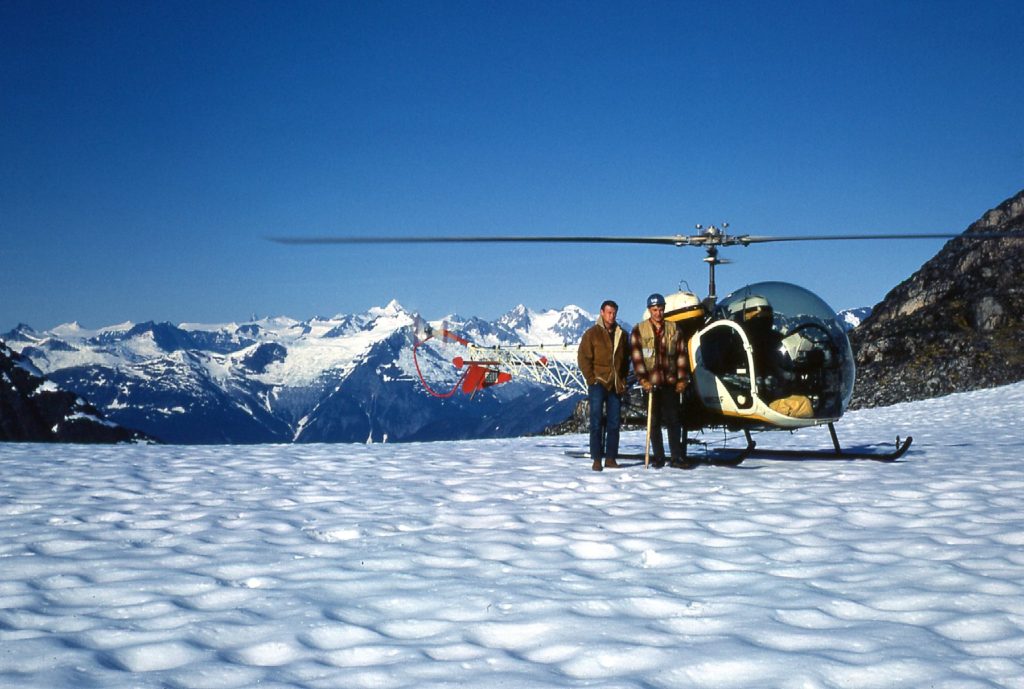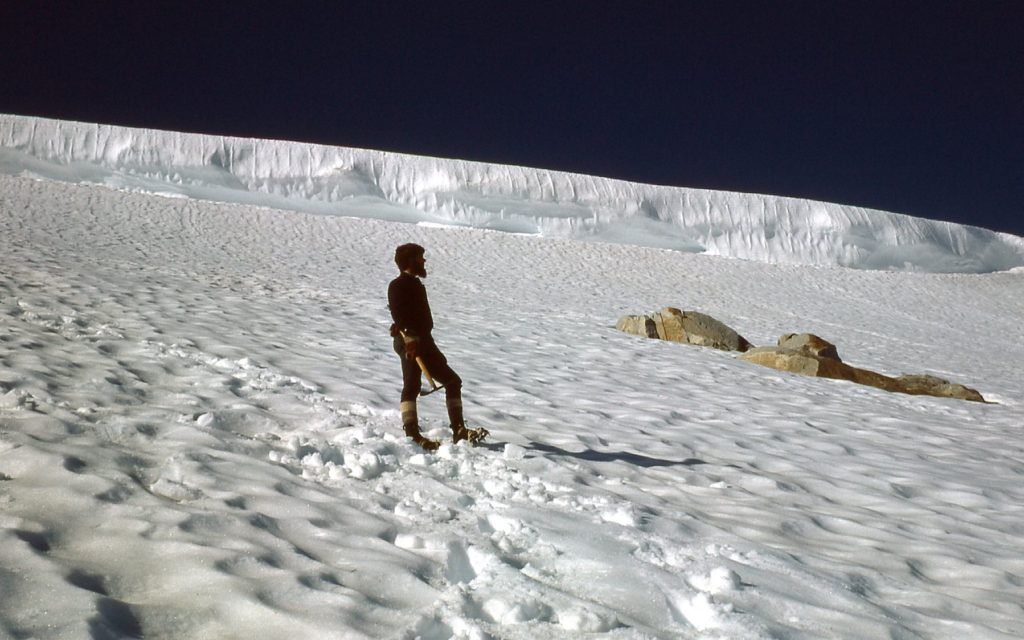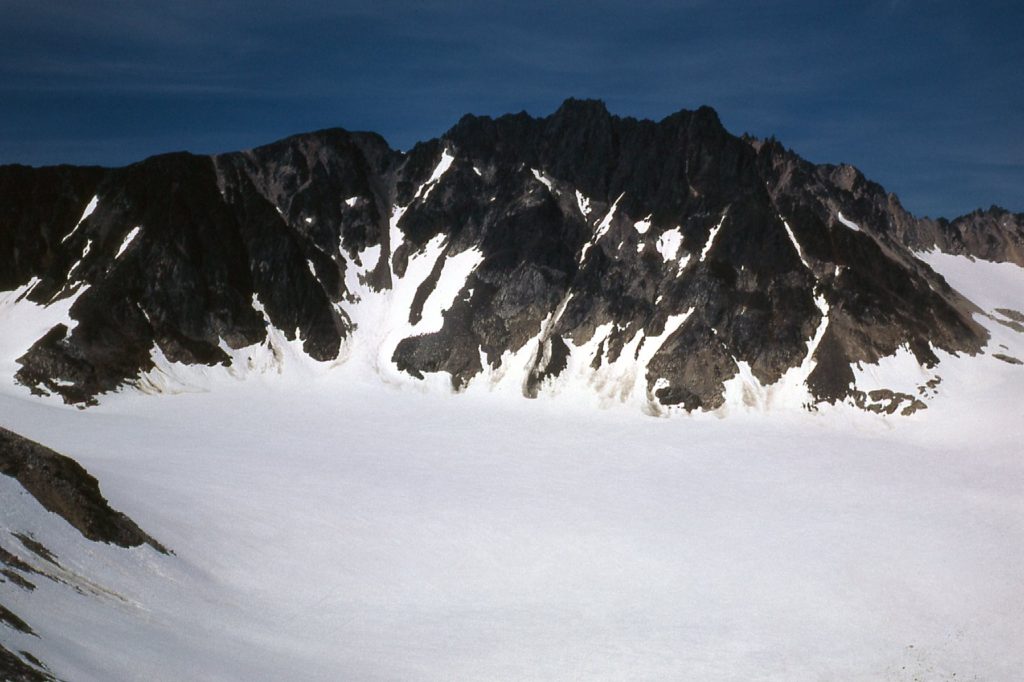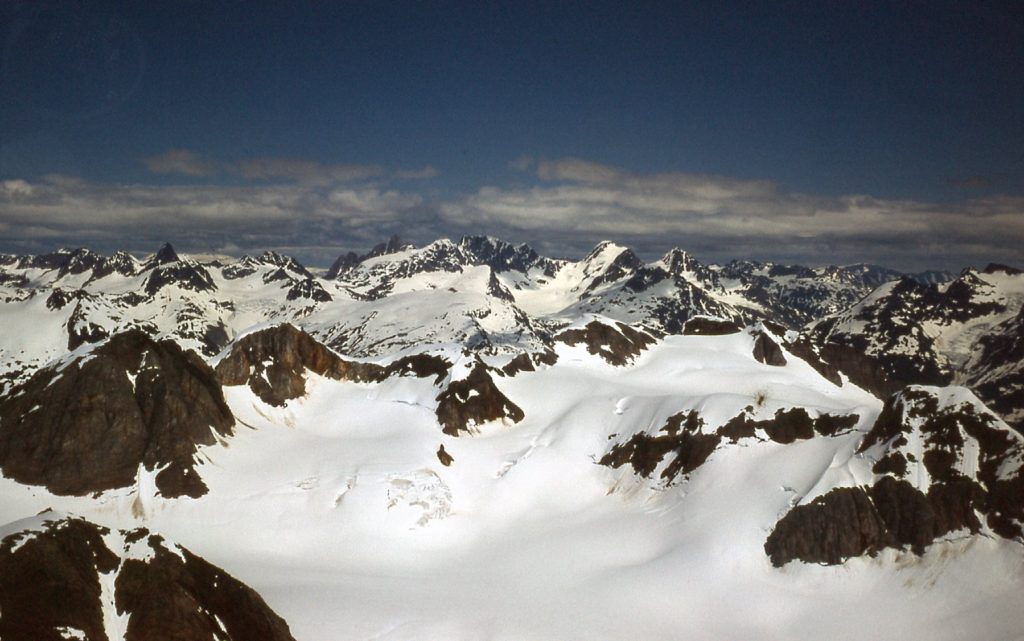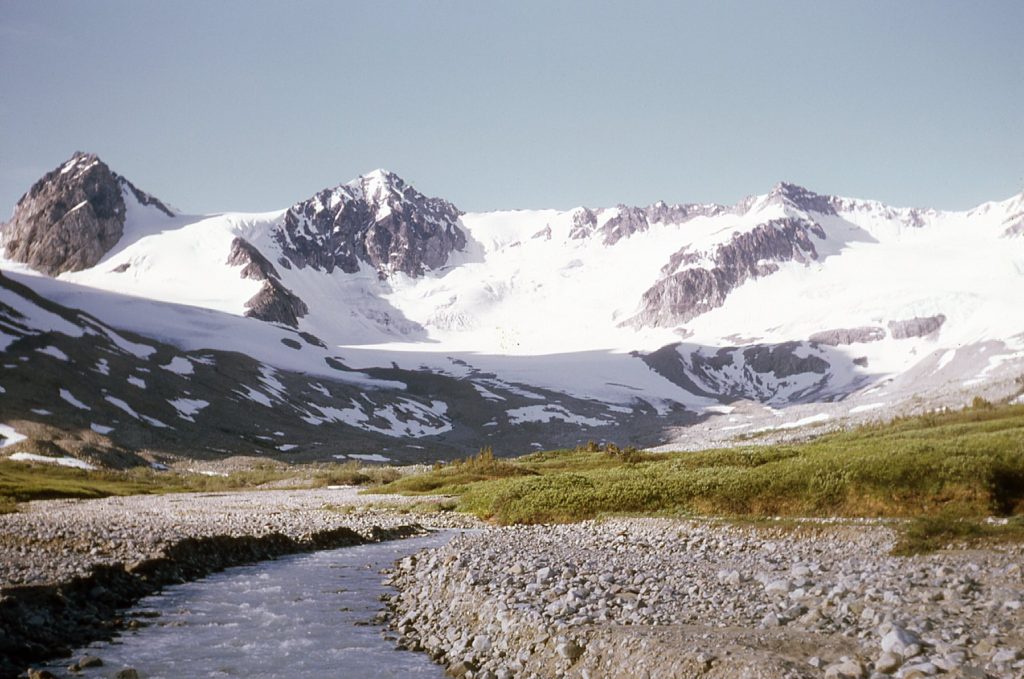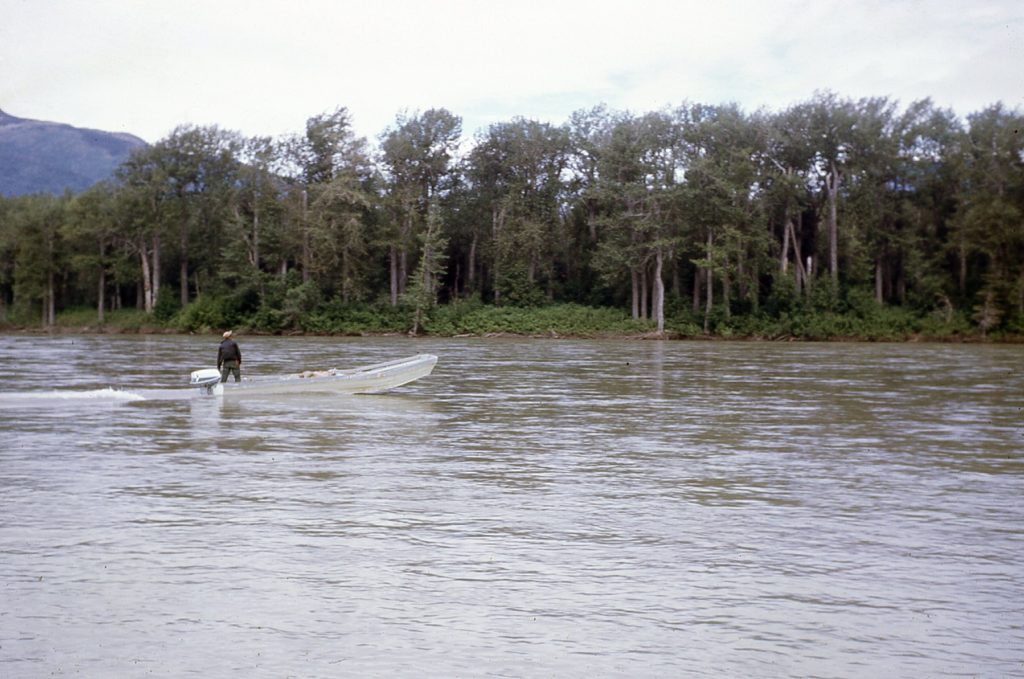Here follows the continuation of my story about the field season I spent in the Stikine region of British Columbia in 1967. Please read Part 1 before you read this one.
Camp life was comfortable. We had 3 excellent meals a day – no company could ever afford to skimp on the quality or quantity of food for a crew working out in the bush. Napoleon was quoted as saying that “an army marches on its stomach”, meaning that in order to be effective an army relies on good and plentiful food. Our cook was a cantankerous old alcoholic named Pat Downey, a WWII veteran. He was a character, but man, could he cook! His was the hardest job in camp, up at the crack of dawn to prepare a hot breakfast of meat, eggs and plenty else to get our day started. If we were heading out for the day in the chopper, we’d put together sandwiches and whatever else we wanted to grab that could travel well in a day pack (cookies, chocolate bars, tinned fish, etc…). Dinner back in camp would be a big hot meal and was looked-forward-to by all. It would be late by the time all was cleared away.
Since our camp was in the bush in a place where you could only fly in, we couldn’t drive anywhere. We had to fly everywhere by helicopter in order to do our work, so if the weather was too poor to fly or the chopper needed repairs or maintenance, we didn’t go anywhere. Idle days in camp were spent playing card games such as hearts or bridge, playing horseshoes or reading. Getting some extra shut-eye was always a good option.
I had with me a powerful transistor radio, and one of the first things I did once we set up camp was to put up a good aerial to improve reception even more. Listening to the radio was a major source of entertainment, and even during the day I could pick up stations in Ketchikan and Juneau (150 miles and 125 miles away, respectively). At night, signals poured in from everywhere and we could tune in to stations in Vancouver, Edmonton and the States with ease.
A plane arrived every Monday and Friday and landed on our rough air strip on its big balloon tires. This was our lifeline, and it brought in everything we needed – fresh and canned food, camp equipment, personal items we had requested, and most importantly, the mail. Sometimes bad weather would delay the plane by a day or two, and it was always sorely missed. It was no casual flight, requiring a full 2 1/2 hours from the town of Terrace, BC far to the south, so the weather really needed to cooperate in order for the pilot to set out for our camp.
I mentioned how important getting our mail was to us. As I read back through the diary I kept that summer, almost daily I would comment on what mail had come in for me on the semi-weekly flight and what letters I had prepared to send out each time. In retrospect, I was quite the letter-writer, keeping a running correspondence with friends and family – I really craved getting letters!
So as I already mentioned, on days when the weather allowed, two of us plus pilot would take off – he would whisk us away and fly for as much as an hour or even more to reach a place where he’d drop us off. Perhaps high on a ridge or a mountain top, or sometimes in a valley bottom. He’d make it crystal-clear where he’d pick us up at the end of the day, flying over the exact spot on the way in. Our chopper was a Bell G3B, a nice little machine in common use at the time. It had a payload of 800 pounds (above and beyond fuel and pilot) and a range of 215 nautical miles. It could climb 860 feet/minute, could cruise at 85 miles per hour and had a flat-out maximum speed of 105 mph. An hour’s flying time could take us a long way from camp. For example, here’s a day when we flew to Mount Oksa. I’m taking this next photo while the chopper sits there, rotor turning.
Just to the left of center in the above photo, on the far horizon, sits a white pyramidal peak – that’s Kate’s Needle, a full 10,016 feet, over in the Boundary Ranges. It’s only 25 miles from where we’re standing and only 46 miles from camp. This next shot shows how a lot of our days were spent, on ice and snow.
There was permanent snow down pretty low in this region. This next shot was also taken on Mt. Oksa, from the 5,000-foot level
One day early in the season, our chopper pilot and mechanic took off from camp and didn’t return at the end of the day. We didn’t know what had happened to them, and everyone went into a panic. We got on the 2-way radio and started calling other camps in the region, asking if anyone had seen them. Nobody had, and soon an all-out search was under way. Well, a day later, the chopper pilot from another camp spotted them. They were sitting on a sand bar in the Scud River not 20 miles from camp, safe and sound – they had run out of fuel. A big embarrassment for a pilot, I would think. After ferrying fuel from our camp, they soon returned.
In the bush near our camp, we had dug a big garbage pit. All our trash and food scraps were put out there, doused with avgas and burned. Still, bears were attracted to it and could become a nuisance. One of them just wouldn’t leave, and one of the bosses had to shoot it. I decided to tan the hide, and asked for some oxalic acid to be shipped in to camp. After all was said and done, I’d done a fair job of tanning it and had it for many years afterwards.
We continued to head out on daily trips to prospect. Our two bosses would decide on places of geological interest and then send us out. This was my favorite type of activity. Just think of it, getting a chance to go out into amazing wilderness like this, poke around at a few rocks, and even get paid for it.
Once in a while, we’d have a bit of excitement, like the day the pilot dropped us off here above tree-line. He took off, and before long we saw something moving up ahead. It turned out to be a mother grizzly bear with her two cubs. She stood up on her hind legs to get a better look at us, but soon decided we weren’t of too much concern and ambled off, her cubs in tow.
One day, we were dropped off to do a little prospecting near the mouth of Kirk Creek where it flows into the Stikine. There, we found some old cabins, one of them still usable. Inside, among other relics, were some copies of an old publication called “The Nor’west Prairie Farmer”, with issues dated 1916, 1917 and 1918. I love finding old stuff like that. At mid-day, we were standing on the bank of the mighty Stikine River when we heard a noise, and it wasn’t our chopper. Coming up the river was a motor boat – we shouted and waved, and it came over to us.
It was an Indian fellow who lived at Telegraph Creek. He was as surprised as we were to run into anyone out there, and we talked for a while. He motored on upstream after a bit.
Did I mention the mosquitoes? They abound in the far north, along with many other biting insects who are their cousins. That afternoon on the bank of the river, they seemed particularly abundant. The chopper was late in returning for us, so to pass the time we played a little game. My partner and I both rolled up our shirtsleeves past the elbow and allowed the voracious mozzies to land on our bare skin, then had a competition to see who could kill the most with one slap of the hand. He won, with 17 killed in one blow.
In late June, the bosses spent a lot of chopper time looking for good spots to place some fly camps. Allow me to explain what those were. A fly camp is a spot where you fly in, usually to a fairly remote place out in the middle of nowhere, and are dropped off for a period of time with everything you’ll need to survive while there. In our case, that meant that our chopper would fly 2 men in to a spot. All your gear and food would be suspended from a sling below the chopper, and when the pilot came in to land, he’d lower the sling down so it gently touched the ground below and then release it from inside the chopper. Then he’d move over a bit and land so we could get out, and away he’d go. We’d stay there for anywhere from a few days to somewhat longer. Preparing for and setting up these camps involved a lot of work, so the longer we’d stay there the more practical it was.
I mentioned how the chopper could fly with a load in a sling (nothing more than a rugged net) suspended below it. Our pilot was unlucky with slinging. One time he dropped a sling into a lake, where it promptly sank; another time he dropped one while flying high above a glacier. It fell so far and fast that when it hit the ice, everything in it was obliterated. These incidents caused some valuable gear to be lost, which took time to replace by means of our supply runs twice a week.
Near the end of June, all was in readiness for us to begin these fly camps. A new phase of our work was about to begin, and I was excited.
Stay tuned for the next installment of the story, entitled “The Stikine – Part 3”.

